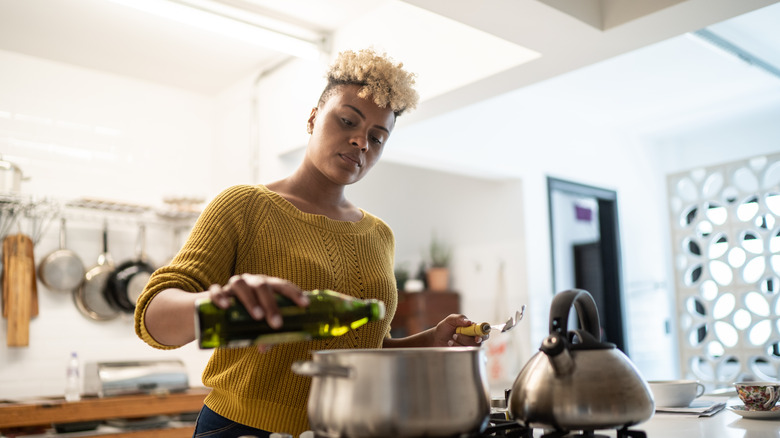Martha Stewart's Advice To Save Money On Premium Olive Oil
We're all trying to save money at the grocery store these days. With shoppers feeling the sting of rising prices of everything from staples to produce, even the most discerning and choosiest ingredient snobs among us are cutting corners and finding affordable alternatives that don't sacrifice taste. Granted, when thinking of economic, down-to-earth gurus, Martha Stewart might not be the first person who springs to mind — but it turns out that the longstanding queen of entertaining and homemaking has a trick up her sleeve for saving money on one of the priciest of pantry staples — olive oil.
Not all bottles on the oil aisle are created equal. You've probably noticed that primo extra virgin olive oils are often many dollars more than the price of virgin or regular varieties. Marta Stewart's advice, as she writes in Deseret News, is to keep one bottle of each type in the cupboard: a cheaper daily workhorse bottle to use for cooking, sauteing, and dressings; and a premium bottle to be used in dishes and dips where it can truly shine. The difference in price and quality has to do with the various types of processing to extract the fragrant oil from the olives. Extra virgin olive oil is made via a "cold pressing" method without heat or chemicals. This creates a darker, stronger flavored oil compared to the virgin variety or regular olive oil. While both types are still delicious, those are considered slightly lower quality than extra virgin olive oil.
Grab different bottles depending on the dish you're making
In an ideal world, we'd all reach for that gorgeous glass bottle of top-shelf EVOO — for everything from sauteing, to adding a drizzle to your toast, or whipping up a quick salad dressing. In the real world, Martha Stewart says to save the good stuff for the recipes where the olive oil's flavor will shine through. Before you begin making a dish, ask yourself, will your tastebuds truly pick up on what the olive oil is bringing to the party, or is the oil more of a background character?
For example, when making a homemade salad dressing with numerous other competing flavors like vinegar, lemon juice, garlic, and spices, save yourself some of that hard-earned money and use your lower-grade olive oil. You could use canola oil for dressings, but any vegetable oil will work just fine. When sauteing your onions, garlic, and other veggies, don't waste your precious extra virgin olive oil; the heat will burn off much of its flavor and aroma anyway. But as Martha Stewart suggests — when you're enjoying homemade pasta with olive oil overtop, whipping up a restaurant-worthy bread oil dip, or drizzling oil over toast with flaky sea salt — these are EVOO's moments.

